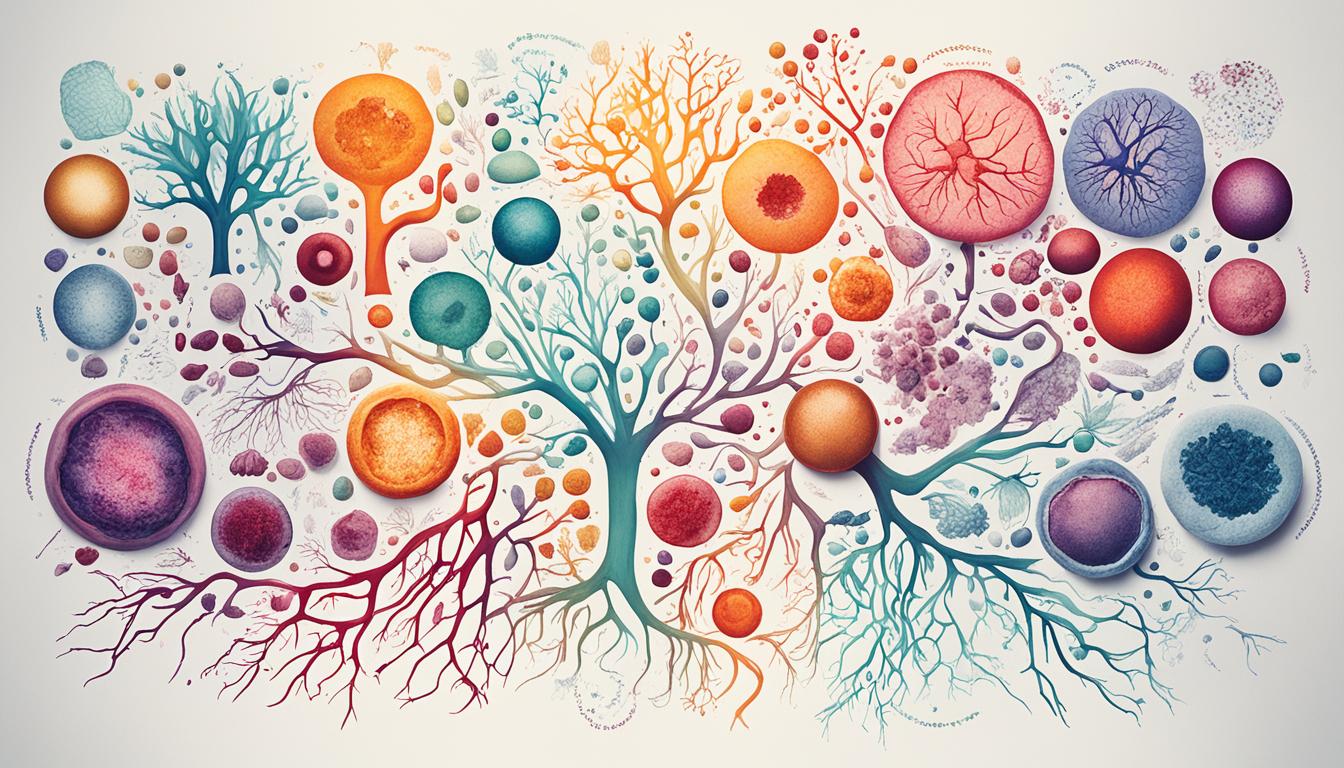Systemic mastocytosis is a rare, aggressive disorder. It’s marked by the overactivity of mast cells. These are immune cells that trigger inflammatory reactions. People with this condition might feel anaphylaxis, flushing, or have stomach and brain issues.
Mast cells act up in systemic mastocytosis due to IgE and non-IgE methods. The KIT gene controls their growth. Mutations in this gene help cause the disease.
To diagnose, doctors look at a person’s history, do a medical exam, run tests, look at bone marrow, and do imaging. These steps show how widespread the condition is in the body.
Doctors treat systemic mastocytosis to handle symptoms, cut down on triggers, and decrease mast cell activity. They might use antihistamines, pump inhibitors, or even steroids. For severe cases, they might suggest stem cell transplantation.
Key Takeaways:
- Systemic mastocytosis is a disorder marked by too many mast cells.
- It shows up in symptoms like anaphylaxis and stomach troubles.
- The KIT gene is key, and its mutations help cause the disease.
- Diagnosing it needs a thorough look at past health, tests, and exams.
- Treatments focus on easing symptoms, with stem cell transplants for extreme cases.
Types and Symptoms of Systemic Mastocytosis
Systemic mastocytosis appears in five main types. These are ISM, smoldering, SH-AHNMD, ASM, and MCL. ISM is the most common, moves slowly, while ASM and MCL are severe. They may harm organs.
Symptoms of systemic mastocytosis vary by the affected organ. Common signs are skin reactions, itching, and flushing. Also, there are stomach issues, pain in muscles and bones, thinning bones, and blood problems. Some feel depression and anxiety too.
It’s key for those with systemic mastocytosis to find and avoid triggers. They should also use medicines and change their lifestyle to help manage symptoms.
Types of Systemic Mastocytosis
Systemic mastocytosis has different types depending on how severe it is and how fast it grows:
| Type | Description |
|---|---|
| Indolent Systemic Mastocytosis (ISM) | The most common type, progresses slowly with mild symptoms. |
| Smoldering Systemic Mastocytosis | Characterized by stable symptoms and slow disease progression. |
| Systemic Mastocytosis with an Associated Hematologic Nonmast Cell Lineage Disorder (SH-AHNMD) | Involves the presence of non-mast cell blood disorders in addition to systemic mastocytosis. |
| Aggressive Systemic Mastocytosis (ASM) | A more severe form of the disease that can cause organ dysfunction and systemic complications. |
| Mast Cell Leukemia (MCL) | A rare and aggressive form where abnormal mast cells infiltrate the blood and bone marrow. |
Symptoms of Systemic Mastocytosis
People with systemic mastocytosis have varied symptoms by their affected organs. Symptoms might include:
- Skin reactions, such as hives, rashes, erythema, and dermatographism.
- Itching (pruritus) and flushing.
- Gastrointestinal issues, including abdominal pain, diarrhea, and nausea.
- Musculoskeletal pain and joint stiffness.
- Osteopenia or osteoporosis, leading to an increased risk of fractures.
- Anemia and reduced blood cell counts.
- Neuropsychiatric manifestations, like anxiety, depression, and cognitive impairment.
Things like foods, medications, and stress can make symptoms worse. But, not everyone with the condition finds clear triggers for their symptoms.
Getting diagnosed early and managing the condition well can really help the treatment work better for individuals with systemic mastocytosis.
Diagnosis and Treatment of Systemic Mastocytosis
Systemic mastocytosis is diagnosed through a detailed process. This includes looking at symptoms, your medical past, and checking your body. Doctors also do a series of tests. These might involve a full blood count, checking how your liver and kidneys work, serum tryptase, and genetic tests for KIT gene changes. For a closer look, a bone marrow biopsy, imaging, and a scope to check the stomach and intestines are also done.
Tackling systemic mastocytosis depends on its type and how serious it is, as well as the impact on your body. The main goal is to ease symptoms, avoid triggers, and lower mast cell activity. You may be prescribed antihistamines, epinephrine for severe reactions, proton pump inhibitors, mast cell stabilizers, or steroids. For severe cases, targeted drugs, chemo, or even a stem cell transplant are possible. Regularly checking in with your doctor is vital to track your progress and see how your treatment is doing.
If someone has advanced mast cell leukemia, using stem cell treatment might help. This method aims to introduce new, healthy stem cells. Changing the diseased cells with fresh ones could improve how well you are and your life quality.

